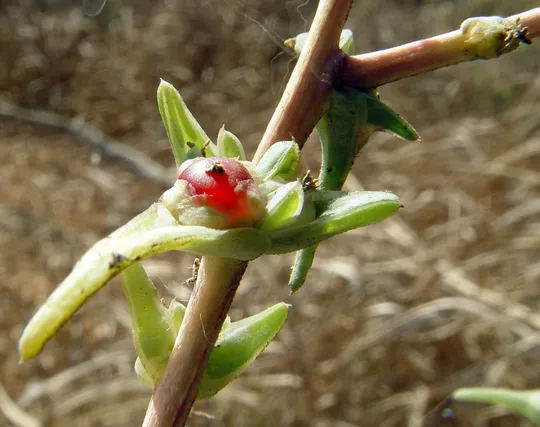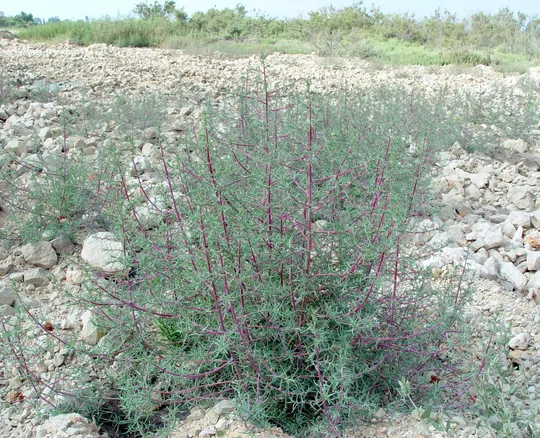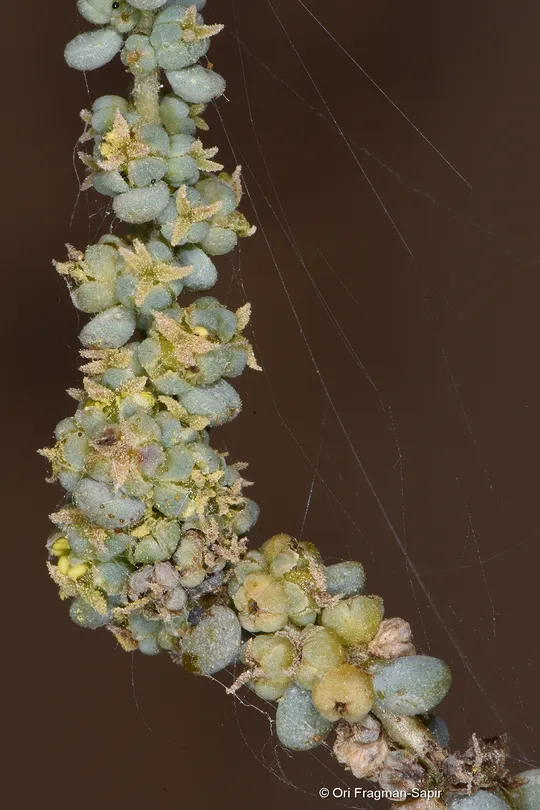Oppositeleaf Russian Thistle, Barilla Plant
Salsola soda


Salsola soda was a
major source of soda ash that was once used for making soap, hence its name. In
Japan, the leaves and stalks are eaten after being cooked in water.
Salsola soda is found in the Acre
and Jezreel valleys at ten documented sites, but it probably survived at only eight.
In the Acre Valley, it is located in two sections – in the Acre-Naaman Stream section
and in the Kishon-Yagur-Check Post section. Talia Oron recently reported the
presence of the plant in the estuaries of the Betset, Kziv, Bet HaEmek and
Yasif streams. Itsik Raz found it in 2009 in the Jezreel Valley near Yif'at. In
the 1920s-'40s S. soda was collected in
the Kebara area on the Carmel Coast, although it has not been found there
since. It was recently found near Tel Hatsor on the edges of the Hula Valley.
Salt marshes on
the coastal plain, brackish winter pools, edges of salt pans.
The genus Salsola
consists of about 150 species, mostly growing on steppes, deserts, beaches and
salt marshes, mainly in Eurasia and Africa. Some species also grow in America
and Australia.
•
In the past Salsola sodagrew
in two regions – the Acre Valley and the Carmel Coast – however it now grows
with certainty in just one region – the Acre Valley. In this region, there seemed
to be a decreasing trend in the number of sites towards the 1990s. However,
recent reports from the early 2000s indicate the presence of additional sites that
were not previously known at stream mouths in the Acre Valley. It is unclear
whether these observations reflect the increased sampling effort or the new colonizations.
•
The Salsola soda
populations observed at the sites number between dozens to thousands of plants.
There is insufficient information regarding long-term fluctuations and trends
in population size.
•
Israel's coastal
salt marshes, most of them adjacent to stream estuaries, are disappearing due
to development activities, flow modifications and water quality. Habitat loss
and deterioration are the main threat to the continued existence of S. soda populations.
•
S. soda
is apparently only protected in the En Namfit
Reserve.
•
The global distribution
of S. soda is extensive and it is apparently not globally
endangered. In addition to Israel the species is listed in the Red Book of
Cyprus, and according to the IUCN is classified as VU = vulnerable, in Croatia.
The Na'aman estuary should be declared a nature reserve,
as it is almost the only site in Israel that represents the flora and
vegetation of coastal salt marshes. The surveys to locate Salsola soda populations and obtain estimates based on population size and long-term
trends should be renewed, in order to establish reliable assessments of the status
of the species in Israel.
Salsola soda grows in coastal
salt marshes in all the Mediterranean countries, North Africa and the
Mediterranean islands. It is also found on the Atlantic coast of the Western
European countries and on the Black Sea coast. The plant also became
naturalized on the Pacific coast of North America where there is concern that
it is an invasive species.
Salsola soda is an annual
plant growing in the coastal salt marshes in the Acre Valley. It is extinct on the
Carmel Coast and some parts of the Acre Valley. On the other hand, new sites
have recently been found. The main threat to S. soda is the
disappearance and deterioration of its habitat – the coastal salt marshes. It is
not globally endangered.
ויזל, י. ואגמי, מ. 1979.צמחי מלחה בישראל. הוצאת המדור לאקולוגיה, פתח תקווה.
Current Occupancy Map
| 1000 squre meter pixel | 5000 squre meter pixel | 10000 squre meter pixel | |
|---|---|---|---|
| number of observations | 0 | 0 | 0 |
| in total pixels | 0 | 0 | 0 |
| Family | Chenopodiaceae |
| Classification | On the near threatened species list |
| Ecosystem | Mediterranean |
| Chorotype | Multi regional - Tropical |
| Conservation Site | Na'aman Estuary Nature Reserve |
| Rarity |
1
1
6
|
|---|---|
| Vulnerability |
0
3
4
|
| Attractiveness |
0
0
4
|
| Endemism |
0
0
4
|
| Red number |
1
2.6
10
|
| Peripherality | N |
| IUCN category | DD EW EX LC CR EN VU NT |
| Threat Definition according to the red book | Near threatened |
 Based on:
Based on:






